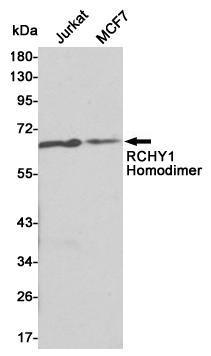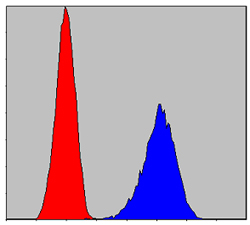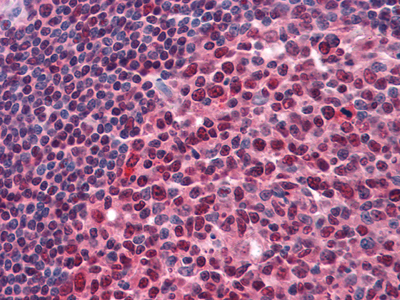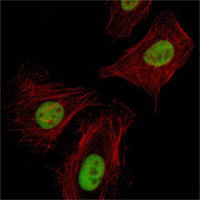-
Product Name
Anti-Pirh21 (7B9) Mouse antibody
- Documents
-
Description
Pirh21 (7B9) Mouse monoclonal antibody
-
Tested applications
WB, IHC-P, ICC/IF, FC
-
Species reactivity
Human, Rat
-
Isotype
Mouse IgG1
-
Preparation
Antigen: Purified recombinant fragment of human Pirh2 expressed in E. Coli.
-
Clonality
Monoclonal
-
Formulation
Ascitic fluid containing 0.03% sodium azide.
-
Storage instructions
Store at 4°C short term. Store at -20°C long term. Avoid freeze / thaw cycle.
-
Applications
WB: 1/500 - 1/2000
IHC: 1/200 - 1/1000
ICC: 1/200 - 1/1000
FC: 1/200 - 1/400
ELISA: 1/10000
-
Validations

Western blot detection of RCHY1 in Jurkat and MCF7 cell lysates using RCHY1 mouse mAb (1:1000 diluted).Predicted band size:30KDa.Observed band size:60KDa.

Flow cytometric analysis of PC-12 cells using anti-Pirh2 mAb (blue) and negative control (red).

Immunohistochemical analysis of paraffin-embedded human Tonsil tissues using anti-Pirh2 mouse mAb

Immunofluorescence analysis of Hela cells using Pirh2 mouse mAb (green). Red: Actin filaments have been labeled with Alexa Fluor-555 phalloidin.
-
Background
Swiss-Prot Acc.Q96PM5.Pirh 2 (P53 induced RING-H2 protein), also known as RCHY1, it forms dimers through its N- and C-terminus in cells. The Pirh2 has ubiquitin-protein ligase activity and it binds with p53 and promotes the ubiquitin-mediated proteosomal degradation of p53. The Pirh2 is oncogenic because loss of p53 function contributes directly to malignant tumor development. Pirh2 expression decreases the level of p53, and a decrease of endogenous Pirh2 expression increases p53 levels. Pirh2 is therefore considered, together with MDM2, to act as a negative regulator of p53 function.
Related Products / Services
Please note: All products are "FOR RESEARCH USE ONLY AND ARE NOT INTENDED FOR DIAGNOSTIC OR THERAPEUTIC USE"
